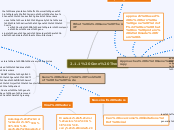2.1.1 Gene Therapy
Approaches to Gene Therapy
sometimes just adding a working copy of the gene won't solve the problem
What is Gene Therapy?
the transplantation of normal genes in place of missing or defective ones to correct genetic disorders
uses a vector (typically a virus) to deliver a gene to the cells
cell builds RNA and protein molecules from correct gene
single gene genetic disorders are better candidates than multifactorial
Gene Delivery: Tools of the Trade
vectors are DNA delivery vehicles
vectors are customized to address unique features of disorders
vectors must: TARGET the right cells, INTEGRATE the gene, ACTIVATE the gene, and AVOID harmful side effects
in vivo is to inject the vector directly into the patient
ex vivo is to deliver the gene to cells that have been removed from the body and are growing in culture
Viral Vectors
Advantages of viral vectors:
-good at targeting and entering cells
-can be modified so that they can't replicate and destroy cells
Drawbacks of viral vectors:
-carry a limited amount of genetic material
-can cause immune responses in patients (patients may get sick or immune system may block the virus from delivering the gene to the patient's cells)
Non-viral Vectors
Can overcome limitations of viral
less effective
generally ex-vivo
Types of Mutations Where Adding a Working Copy Won't Work
Improper regulation
Protein is functioning as it should, but there's a problem with where, when, or how much protein is being made.
Problems of gene regulation
Gain-of-function
A gain-of-function mutation makes a protein that acts abnormally, causing problems all on its own (Cancer)
Dominant negative
This mutation leads to production of a dominant-negative protein that may block a normal protein from doing its job
Repairing Mutations
aimed at replacing a defective copy of a gene with a working copy
"Spliceosome-Mediated RNA Trans-splicing" targets and repairs the messenger RNA copied from mutated gene. This technique repairs section of the mRNA rather than entire gene
Viral vectors repair mutations directly in DNA. This tech. uses enzymes target DNA and cut out the faulty sequence and replace with a functional copy.
Gene Silencing
approach used to turn a gene "off" so that no protein is made from it.
Genetically modifying immune cells to target specific molecules
isolates immune cells and genetically engineers them to recognize a specific antigen.
When returned to the patient, modified cells will find and destroy any cells that carry antigen/product
How diseases are chosen for gene therapy
DNA copy of the gene must be available in laboratory.
it is necessary to know which genes will be pursued before treatment
How the gene factors into the disorder?
by knowing which tissues the disorder affects, what role the protein encoded by the gene plays within the cells of that tissue, and exactly how mutations in the gene affect the protein's function, how to go about treating the disorder can be determined
The condition be able to be corrected by adding one or a few functional genes
single gene mutations are better candidates than multi factorial
